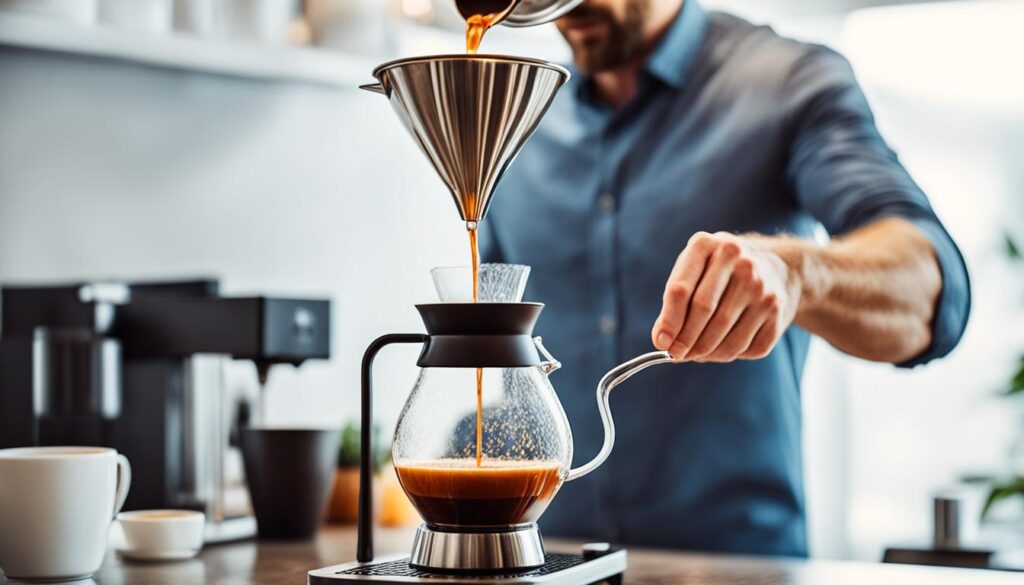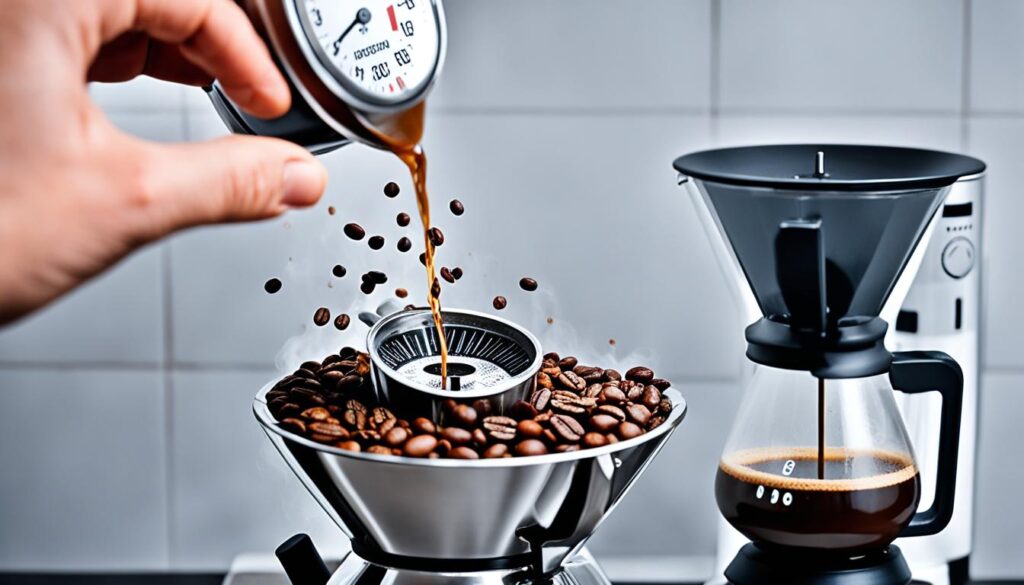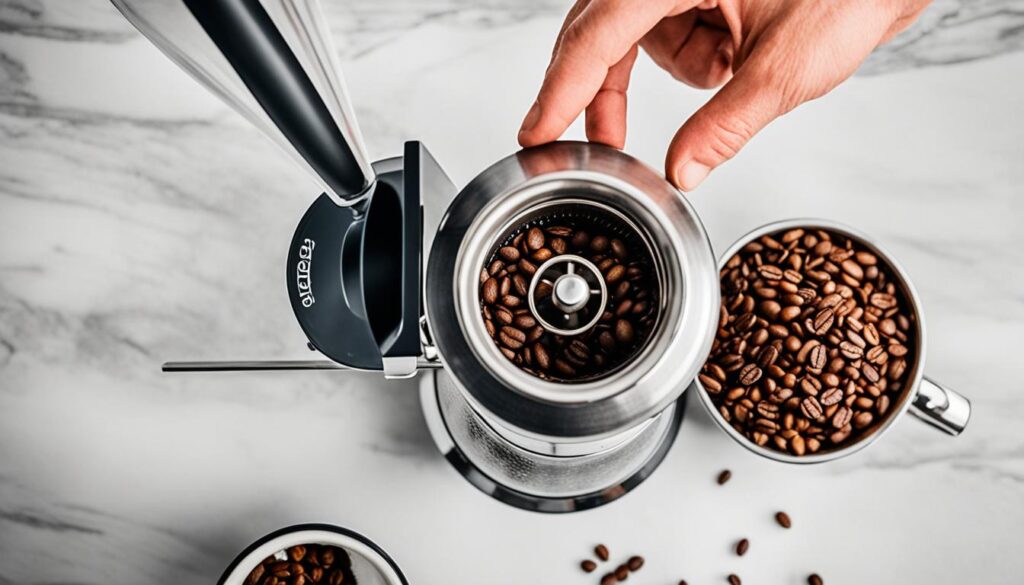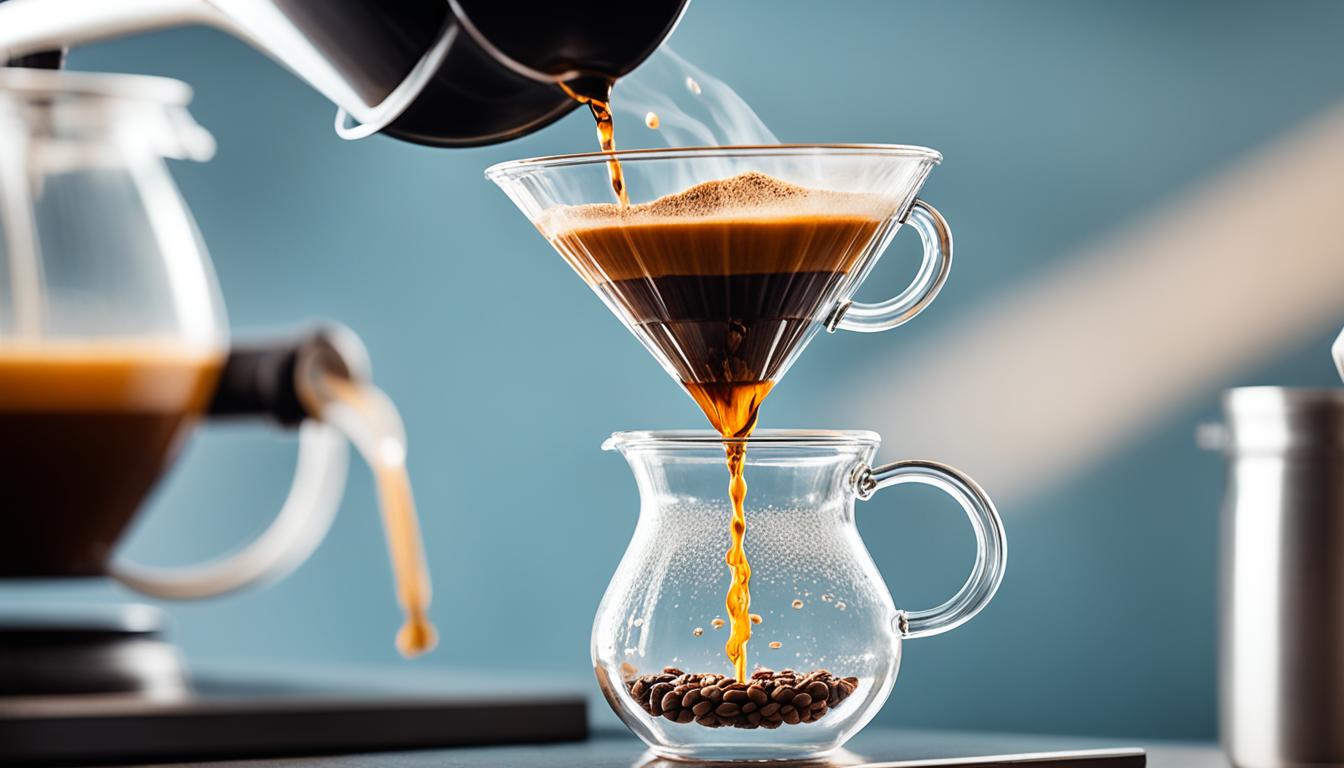Are you ready to take your pourover coffee to the next level? Would you like to unlock the secrets of a perfect, flavorful cup every time? It’s time to delve into the world of temperature and timing in pourover brewing. By understanding how these key elements affect your brew, you can elevate your coffee game and create a truly exceptional cup of pourover coffee.
In order to make better pourover coffee, it’s important to have a grasp on how pourover works. From rinsing the filter to pouring with precision, every step of the process contributes to the final result. But it’s the temperature and timing that can truly make or break your brew.
So, why are temperature and timing so important? How do they impact the flavors and aromas in your pourover coffee? And what are the techniques and tips you can implement to master these crucial aspects? Let’s explore the answers and unlock the secrets to pourover mastery.
Key Takeaways:
- Understanding the role of temperature and timing in pourover brewing
- How temperature affects extraction and flavor in pourover coffee
- The impact of timing on the strength and richness of your brew
- Techniques for achieving optimal temperature and timing in pourover brewing
- Tips for experimenting and refining your pourover coffee to perfection
The Art of Pour Over Coffee
Pour over brewing is a beloved method among coffee enthusiasts due to its simplicity and the control it offers over the brewing process. With the use of a V60 or Kalita brewer, coffee lovers can create a personalized and sensory experience.
| Brewer | Description |
|---|---|
| V60 | The V60 method is particularly favored for its cone-shaped design and spiral grooves, which ensure a consistent extraction and reveal the complex flavors of the coffee beans. |
| Kalita | The Kalita brewer offers a flat bottom and three small holes, promoting an even extraction and providing a balanced and smooth cup of coffee with excellent clarity of flavors. |
Whether using the V60 or Kalita, the pour over method allows for the exploration of a wide range of tastes, from fruity and bright to earthy and rich. The pour over cone design and controlled pouring technique contribute to the uniqueness and versatility of this brewing method, allowing coffee enthusiasts to discover their preferred flavor profiles.
“Pour over brewing offers the opportunity to appreciate the intricacies of every coffee bean, extracting its distinct flavors and highlighting its best qualities.” – Coffee Enthusiast Magazine
The pour over technique involves pouring hot water over coffee grounds in a controlled manner, allowing for precise extraction and customization of each cup. This method offers a hands-on approach that allows the brewer to fine-tune the brewing process, resulting in a coffee that truly reflects their personal preferences.
The V60 method, in particular, has gained popularity among coffee enthusiasts due to its unique design and ability to achieve a balanced and flavorful brew. The cone-shaped dripper, with its spiral grooves, ensures an even extraction by guiding the water flow through the coffee grounds, unlocking the full potential of the beans.
Exploring Flavor Profiles
One of the exciting aspects of pour over brewing is the ability to explore different flavor profiles by adjusting various variables. Coffee enthusiasts can experiment with grind size, coffee-to-water ratio, and pouring technique to create a cup that suits their taste preferences.
- Grind size: A finer grind will generally result in a stronger and more intense flavor, while a coarser grind will produce a smoother and milder cup.
- Coffee-to-water ratio: Adjusting the ratio allows for customization of the coffee’s strength and flavor. A higher ratio will result in a stronger cup, while a lower ratio will yield a milder brew.
- Pouring technique: Controlling the rate and flow of the pour can significantly impact the extraction process. A slow and steady pour helps maintain consistency and ensures an even extraction.
By experimenting with these variables, coffee enthusiasts can develop their own unique pourover coffee techniques and create a truly exceptional cup of coffee.
In the next section, we will explore the essential elements for mastering the pour over brewing technique, including selecting quality coffee beans, understanding the importance of water quality, and the role of the coffee grinder. These elements are crucial for achieving consistent and delicious pourover coffee.
Essential Elements for Mastering the Pour Over
To master the art of pourover brewing, we need to pay attention to several essential elements. Let’s dive into them:
High-Quality Coffee Beans
When it comes to pourover brewing, the quality of the coffee beans is paramount. Opt for freshly roasted whole beans from a local specialty coffee roaster. These beans will bring out the best flavors and aromas in your cup, providing a truly exceptional coffee experience.
Water Quality
Water plays a vital role in pourover brewing, as it constitutes the majority of our coffee. To ensure a balanced extraction, use filtered or spring water with a neutral pH and moderate mineral content. This guarantees that the water won’t overpower the natural flavors of the coffee, allowing them to shine through.
Coffee Grinder
The coffee grinder is a crucial tool for achieving a consistent and uniform grind size, which is important for a balanced extraction. Whether you prefer a burr or blade grinder, make sure it is of good quality and allows you to adjust the grind size according to your preference.
Brewing Equipment
Having the right brewing equipment is key to precision and consistency in pourover brewing. Consider investing in a V60 dripper, gooseneck kettle, and scale. The V60 dripper’s unique design ensures even extraction, while the gooseneck kettle provides precise pouring control. As for the scale, it allows for accurate measurement of coffee and water, ensuring consistency with each brew.
By focusing on these essential elements, we can significantly improve our pourover brewing skills and elevate the quality of our coffee.
| Element | Importance |
|---|---|
| High-Quality Coffee Beans | ✔✔✔ |
| Water Quality | ✔✔✔ |
| Coffee Grinder | ✔✔ |
| Brewing Equipment | ✔✔✔ |
Note: The importance rating above indicates the level of impact each element has on improving pourover brewing. Three checkmarks (✔✔✔) signify the highest importance.

Step-by-Step: Brewing Your Perfect Cup of Coffee
Preparing a perfect cup of pourover coffee requires careful attention to detail and precise execution. By following these step-by-step instructions, you can master the art of pourover brewing and enjoy a delicious, flavorful cup every time.
1. Set Up Your Workspace
Before beginning the brewing process, create a clean and organized workspace with all the necessary equipment readily available. This includes your pourover brewer, filter paper, gooseneck kettle, coffee grinder, scale, and timer. Having everything within reach will ensure a smooth and efficient brewing experience.
2. Measure the Coffee-to-Water Ratio
Accurately measuring the coffee-to-water ratio is crucial for achieving the desired strength and flavor in your cup of pourover coffee. Start by weighing the desired amount of coffee beans based on your preferred ratio. A common starting point is 1 gram of coffee to 15 grams of water, but you can adjust the ratio to your personal taste.
3. The Bloom Pour
The bloom pour is the initial stage of the brewing process where hot water is poured over the coffee grounds to degas and wet them. Start by pouring a small amount of water, around double the weight of the coffee grounds, into the center of the coffee bed. Allow the coffee to bloom for 30 seconds, ensuring that all the grounds are saturated.
4. Slow and Steady Pours
After the bloom pour, continue pouring the remaining water in slow, steady, and circular motions to ensure an even extraction. Pour in a controlled manner, avoiding any sudden or heavy streams that can disrupt the coffee bed. Aim to maintain a consistent flow and keep the water level just below the rim of the brewer.
5. Timing and Total Brewing Time
The total brewing time for pourover coffee should be around 2 to 3 minutes. Adjusting the pour technique and timing allows you to customize the flavor profile of your brew. Experiment with different pour speeds and intervals to find your preferred balance and achieve the desired taste and strength.
6. Taste and Refine
Once the brewing process is complete, it’s time to taste and refine your cup of pourover coffee. Take a moment to savor the aroma and flavor, and make note of any adjustments you may want to make for future brews. Consider experimenting with variations in grind size, water temperature, and pour technique to optimize the flavor profile and enhance your overall brewing skills.
Selecting Quality Coffee Beans
When it comes to brewing pourover coffee, the quality of the coffee beans you choose has a significant impact on the final cup. Selecting high-quality and freshly roasted whole beans should be a priority in your coffee brewing journey.
The roast profile of the beans, whether light, medium, or dark, plays a crucial role in determining the flavor and acidity of the coffee. Lighter roasts tend to have brighter and more delicate flavors, while darker roasts bring out richer and bolder notes. Find the roast profile that aligns with your taste preferences and experiment with different varieties to discover the flavors that excite your palate.
Single-origin coffee, sourced from specific regions around the world, offers an opportunity to explore the diverse flavor profiles of different coffee-growing regions. Each origin brings its own unique characteristics to the cup, whether it’s the bright acidity of Ethiopian beans or the chocolatey richness of Colombian beans.
It’s essential to ensure that the coffee beans you select have been recently roasted. Ideally, choose beans that have been roasted within the last two weeks to ensure maximum freshness and optimal flavor. Freshly roasted beans retain more of their natural flavors and aromas, elevating the overall quality of your pourover coffee.
Remember, the flavor of your brew starts with the quality of your beans. So, take the time to find reputable coffee roasters or specialty coffee shops that offer high-quality beans. With attention to detail and a commitment to using the best possible ingredients, you can elevate your pourover coffee experience and savor the delightful nuances of each carefully selected coffee bean.
Understanding the Importance of Water Quality
When it comes to brewing pourover coffee, water quality plays a fundamental role in the final taste and flavor of your cup. The minerals present in the water can significantly impact the extraction process, either enhancing or overpowering the natural flavors of the coffee.
We recommend using filtered or spring water with a neutral pH and moderate mineral content. This ensures that the water enhances the coffee’s flavors without overwhelming them. By using high-quality water, you’ll be able to enjoy a clean and well-balanced cup of pourover coffee.
The temperature of the water is also crucial. It should be just off the boil, ideally between 195 and 205 degrees Fahrenheit (90-96 degrees Celsius). This temperature range allows for optimal extraction without scorching the coffee, resulting in a smooth and flavorful brew.
The delicate interaction between water and coffee grounds during brewing requires precision, and using high-quality water helps enhance the overall flavor of your pourover coffee.

| Aspect | Recommendation |
|---|---|
| Water Type | Filtered or spring water |
| pH Level | Neutral pH (around 7) |
| Mineral Content | Moderate mineral content |
| Water Temperature | 195-205°F (90-96°C) |
The Role of the Coffee Grinder
In the realm of pourover brewing, the coffee grinder plays a pivotal role in elevating your coffee experience. With the ability to consistently achieve a uniform grind size, a quality coffee grinder is essential for a balanced extraction and optimal flavor in your cup.
When it comes to choosing a coffee grinder, opt for a burr grinder over a blade grinder. Burr grinders produce a more consistent grind size, ensuring that all the coffee particles are evenly extracted during the brewing process. This leads to a more flavorful and well-rounded cup of pourover coffee.
It’s also important to grind your coffee beans just before brewing. By doing so, you minimize oxidation and preserve the freshness of the coffee. This ensures that the flavors and aromas are at their peak when they meet hot water, resulting in a more vibrant and flavorful cup.
Investing in a quality coffee grinder gives you precise control over the grind size, allowing you to tailor your brewing technique to achieve the desired taste profile. Whether you prefer a coarse grind for a brighter and fruitier cup or a finer grind for a more intense and full-bodied brew, the right grinder allows you to experiment and explore the vast range of flavors that pourover brewing has to offer.
Remember, a consistent and uniform grind size is key to unlocking the full potential of your coffee beans and maximizing the quality of your pourover coffee.

A quality coffee grinder is essential for achieving a consistent grind size, resulting in a more flavorful and well-rounded cup of pourover coffee.
Importance of the Right Brewing Equipment
When it comes to achieving a successful pourover brew, selecting the right brewing equipment is essential. Each piece plays a vital role in enhancing the overall brewing experience and ensuring a better cup of pourover coffee. We believe that using high-quality and reliable equipment is the key to unlocking the full potential of your coffee beans. Let’s explore the essential brewing equipment that every pourover enthusiast should have:
V60 Dripper
The V60 dripper is a popular choice among coffee lovers due to its unique design and versatility. Its cone-shaped design and spiral grooves allow for a consistent extraction and optimal flavor development. Whether you prefer a fine or coarse grind, the V60 dripper can accommodate different grind sizes, making it suitable for various brewing techniques.
Filter Paper
Using the appropriate filter paper is crucial for achieving a consistent flow rate and flavor in your pourover coffee. High-quality filter papers ensure that oils and sediments are effectively filtered, resulting in a clean and smooth cup. Choose filter papers specifically designed for pourover brewing to enhance the clarity and complexity of your coffee.
Gooseneck Kettle
A gooseneck kettle provides the control and precision necessary for an exceptional pourover brew. Its narrow and curved spout allows for a slow and steady pour, ensuring even saturation of the coffee grounds. This precise pouring technique helps achieve an optimal extraction and consistent flavor in each cup.
Scale
An accurate scale is a valuable tool in pourover brewing. By measuring the exact amount of coffee and water, you can achieve consistency in each brew. This allows you to experiment with different ratios and fine-tune your brew to suit your taste preferences. Investing in a scale ensures that your coffee-to-water ratio remains consistent, resulting in a reproducible and satisfying cup of coffee.
By investing in high-quality brewing equipment, you can elevate your pourover coffee brewing to new heights. Each piece serves a specific purpose in the brewing process, contributing to the final flavor and overall experience. Remember, the journey to mastering pourover coffee techniques begins with the right tools!
Achieving the Right Coffee to Water Ratio
In pourover brewing, the coffee to water ratio is a key element that determines the strength and flavor of your brew. While a general guideline is to use a ratio of 1 gram of coffee to 15 grams of water, personal preferences can vary. Adjusting the ratio allows you to customize your coffee to achieve the perfect balance of strength and taste.
For consistency in each brew, it is recommended to use a scale to measure both the coffee and water. This precision ensures that you can replicate the desired results every time you make your favorite pourover coffee. Taking the time to find the right balance between the coffee and water will greatly contribute to your overall brewing success.
Coffee to Water Ratio Guide
| Coffee in grams | Water in grams |
|---|---|
| 15 | 225 |
| 20 | 300 |
| 25 | 375 |
| 30 | 450 |
Use the table above as a starting point for your coffee to water ratios. You can experiment with different ratios to achieve the strength and flavor profile that suits your preference.
Remember, brewing pourover coffee is an art that combines technique, timing, and ratios. By understanding and mastering these elements, you can consistently create a delicious cup of coffee tailored to your taste.
The Art of Pouring: Technique and Timing
Pouring technique and timing are crucial aspects of pourover brewing that significantly impact the flavor profile of your coffee. Mastering these techniques requires practice and attention to detail. Let’s explore the key elements of the art of pouring and how they contribute to a superior cup of pourover coffee.
Blooming: Flavor Development Begins
When starting a pourover brew, the initial step is called the bloom pour. This involves pouring a small amount of hot water over the coffee grounds, allowing them to degas and release trapped flavors. The bloom pour kickstarts the extraction process and sets the stage for a more flavorful cup of coffee.
During the bloom pour, you’ll notice the coffee grounds expanding and bubbling as they release carbon dioxide. This is an important stage for flavor development. Allow the coffee to bloom for about 30 seconds before proceeding to the next pour.
Pouring Techniques: Ensuring Even Extraction
The subsequent pours in pourover brewing should be performed with precision and consistency to ensure an even extraction of flavors from the coffee grounds. Here are a few key techniques to keep in mind:
- Pour slowly and steadily to avoid disturbing the coffee bed. Aim for a controlled pour that distributes the water evenly.
- Use a circular or spiral motion while pouring to cover the entire coffee bed. This helps to extract flavors uniformly.
- Avoid pouring directly onto light spots that may form on the coffee bed. These spots indicate under-extraction and can lead to an imbalanced flavor profile.
By adopting these pouring techniques, you can maintain consistency throughout the brewing process and achieve a well-extracted, flavorful cup of pourover coffee.
Timing: Finding the Sweet Spot
The timing of your pourover brew plays a crucial role in determining the strength and flavor of the final cup of coffee. It’s important to find the right balance between the total brew time and the specific pour timings. Ideally, the entire brewing process should take between two and three minutes.
Adjusting the pour timing allows you to customize the flavor profile of your pourover coffee. A slower pour can intensify the extraction and result in a fuller-bodied cup, while a faster pour may highlight brighter and more delicate flavors. Experiment with different pour timings to discover your preferred taste.
Remember, timing is key, and finding the sweet spot for your desired flavor profile requires practice and experimentation.
Now that you understand the art of pouring and its impact on pourover brewing, let’s explore the final section of our guide where we discuss the conclusion and summarize all the important aspects of making better pourover coffee.
Conclusion
In conclusion, mastering the art of pourover brewing is a journey that requires understanding the principles of how pourover works and honing temperature and timing. By carefully selecting high-quality coffee beans and using the right water and equipment, we can create an exceptional cup of pourover coffee.
Experimenting with different variables and techniques allows us to refine our brew and create a personalized coffee experience. Attention to detail and practice are key in achieving consistently great results. With dedication and passion, anyone can make better pourover coffee and elevate their coffee brewing skills.
Remember, the temperature and timing of the pourover process are vital. Understanding the role they play in extracting the flavors of the coffee beans is crucial for achieving a balanced and delicious cup of coffee. By following the tips and techniques outlined in this guide, we can unlock the full potential of our pourover brewing and indulge in the rich flavors and aromas that this brewing method has to offer.
